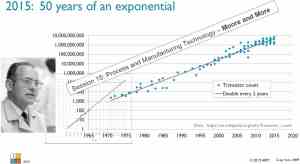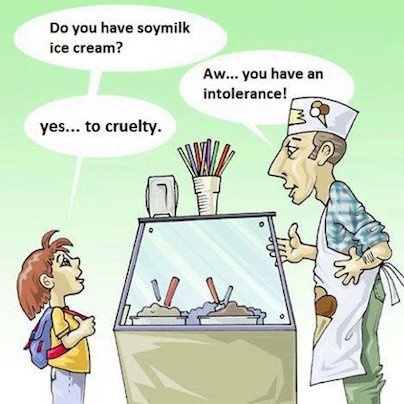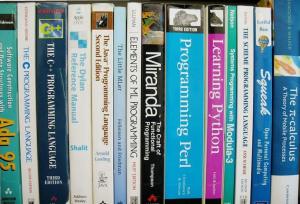Let’s flip the toggle switch on my steampunked time machine and head back to 1975 — the year Gordon Moore revised his hypothesis on the potential exponential growth of computing power, now known as Moore’s Law: computing power doubles every two years. He surprised himself at its curious accuracy.

Let’s go back to 1975, a year when Singer built business computers — I worked on a Singer System 10. That sewing-machine outfit made a foray into small business systems, a foray that ended abruptly in 1976.

Ten years later I was assigned the task of converting a completely manual order processing system at a Cincinnati Milacron division in Blanchester, Ohio. They obtained a small business computer, a wardrobe-sized unit called a CIP 2200B, from the Milacron Products Division. So it was a hand-me-down — with 64K core memory, 10 megabyte fixed disc, 10 megabyte removable disc and a 96 column card reader/punch.
I reported to the corporate boss of information: Pat Goggins. She was a wonderful iconoclast who ruffled many corporate functionaries. I have a soft spot in my soul for independent minds because they threaten the order of things. That is as it should be. Vegans pose a threat to the tyranny of the majority, and that is a very good thing.

The Electronic Circuit Materials Division manufactured board bases for Ford automobiles, crappy scrap for Radio Shack and all manner of integrated circuit users. It was a fascinating place to work in the 1980’s At that time I was a single parent to my two children — my wife Jeanne died in 1983, and I wouldn’t meet Lisa until 1993. so I chucked my suit-and-tie collection into the closet and returned to German language and literatures, a world I had left in 1973. We moved closer to town in 1987. It was a hot and densely humid day. The cicadas sang, the car blew a radiator hose. We were at the shoulder of an interstate. Who populated that vehicle? Myself, my two kids, our cat and our bird.
Coding a program is a lot like learning a foreign language. Database records are words and relationships. Programs have syntax, grammar, logical thought — uttered or iterated.

One kind reader has expressed an interest in my use of pattern-matching techniques, a method called “regular expressions” — an invention of the 1960’s: it still supports many shells glommed around it — devices with modern application. The shoulders of those giants still support us. There is no such thing as a sky hook.
Meanwhile — in the “greater” world — folly tramples on dreams deferred. Do we stand at the rim of an abyss — perhaps of our own making? Dinosaurs peered skyward at the brink of yet another extinction. What other species unknown evolved over billions of years, to return all to primordial casseroles with a punch on the reset button. Five extinction events and counting. This planet is patient and resilient. I like the way my friend Hariod expresses a gentle treasure — confronting imponderables with contentedness. Witness contentedness. Consider this photograph:
Happy Easter 2017 🙂
Thanks for reading.

Kudos, Bill. I commend you on your single parent struggles. You’re a hero in my book. And to others, I suspect.
Singer, for what it is worth, also made or had their name on electric heat package rooftop air conditioning units. They didn’t make them well, either. My opinion.
And while I have the floor, kudos to the threat we vegans pose. And to Hariod’s gospel of Contentedness.
LikeLiked by 2 people
Your very kind words mean a lot to me, Peter. Perhaps I have an overdeveloped sense of responsibility, as do many of the wonderful people we both meet right here on WordPress, all over the world too 🙂
As for Singer, the tech service rep didn’t need many accounts to make a good living, IMO too.
And I hereby pass your kudos forward to all who happen upon these words — including Hariod (also known as Esme’s butler I’ve read ;-)). Wishing Contentedness to all and each!
Hello, carry on, thanks. That’s what I say 🙂
LikeLiked by 1 person
Good to learn a little more of your fascinating life and career, Bill. I think yours has been rather more eventful than my own; although I sense certain echoes in our respective links to developments in microprocessors and the dawning digital revolution. I smile ironically at the “fine two-tone-dial phone with rotary dial”, which would still deliver a clearer and more stable telephony than a great many of today’s mobile ‘phones. Lastly, thankyou very much for your kind mention of my own quiet little corner of the blogosphere. Happy Easter, my friend, Hariod.
LikeLiked by 2 people
Hi Hariod! I fervently hoped that my account of life and times would not cloy and annoy. The post’s title reads like a machine-generated resume, possibly received as sophomoric, soporific or both. Thankyou for gentle kindness in the stead 🙂

You are quite accurate on the vast abyss between the analog and digital worlds. Even party-lines delivered a resonant tone fidelity.
Informing the blogospheric public on your reports of all aspects and perspectives of Contentedness is a service I contentedly provide 🙂
Happy May Day, my friend
LikeLiked by 1 person
I was searching my aunt Pat Gogins and ran into your blog. I’m sure it’s the same person as I know she worked at Milacron as one of the heads of programming. I would love to talk with you about her if you have the time and inclination. My name is Rick I live in Breckenridge, Co. Cheers!
LikeLike
Hello Rick, I am absolutely delighted that you have contacted me about your aunt Pat and I would deem it a privilege to share my memories of her with you. She was an absolutely fascinating person, a great iconoclast — a genuine groundbreaker in those early pioneering days. By “early pioneering days” I mean working with a minicomputer manufactured 27 years after ENIAC: the CIP 2200B (a clone of the IBM System 3) and programming it from scratch in RPGII, the only other program available on that computer was assembler. 🙂
I reported to Pat and am very grateful for the confidence she had in me, so thank you most kindly for contacting me, Rick. I look forward to our correspondence.
Bill
LikeLike